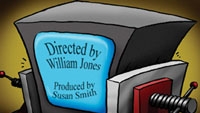Promo squeezes credits
I watched a television program the other night and liked the editing style. I was curious who did the work. At the end of the program, I waited for the credits to roll, and naturally the channel squeezed back for a promo, rendering the text illegible. I never did find out who cut the show. In a world of freelancers, production folk need to publicize their wares, and the closing credits have always been their billboard.
Multichannel broadcasters view credits as dead air. They may have contractual obligations to show them, but they make sure that the credits occupy the minimum possible screen real estate. The other trick is to run the credits so fast that you cannot read them. Combine a lightning fast roll and a squeeze, and then deinterlace the credits in a consumer display, and the credits are rendered unreadable — a bubbling mass of black-and-white pixels.
The next step will be to drop the credits entirely, using the excuse that they cannot be read. Well who made them unreadable? It's all part of the inexorable slide from a craft industry to a content production line. They are not programs; they are products.

I think it's a shame that crediting the creative personnel has given way to commerce. Even tax-funded broadcasters are not immune. One public broadcasting network has even gone to the lengths of defining who can be listed. If you're a colorist, you don't count. The bureaucrats have deemed you have not made a significant creative contribution. This is strange, as I have always found colorists to be well respected. They usually have the nicest cars in the lot at post houses, so why aren't they appreciated by broadcasters?
It used to be up to the director to decide theses matters, but now it falls to a salaryman with little or no understanding of the realities of the vagaries of employment in the world of production. For the broadcasters, their brand has become more important than honoring the creative achievements of the program makers.
At least if I go to a cinema, I can read the credits, although the rest of the audience is usually walking out as the credits run. At live theater, I get a printed program listing everyone down to the under-assistant West Coast promotion man.
One solution could be to run full credits for those who are interested in using some of the features of DTV. New master control technology has enabled the squeeze and tease. There is no reason why technology should not provide the means to show credits in an alternate form.
The professional video industry's #1 source for news, trends and product and tech information. Sign up below.
Digital transmission provides for navigation to subchannels — an ideal vehicle to run the credits. Digital teletext provides another possible means, with the advantage of low data bandwidth requirements. It may be a bit radical for the rights lawyers to change contractual obligations, but the current situation has become an insult to program makers.
Is it odd that I want to see who edited the program? Do you think that running the credits is a historical quirk that has no relevance in 21st century television, or does the crew have a right to be acknowledged? Please e-mail me your thoughts at editor@broadcastengineeringworld.com.
Send comments to:editor@broadcastengineeringworld.com
